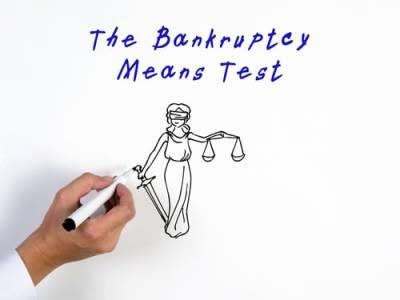What Is the Means Test in a Bankruptcy Case?
 Most Americans owe debts in some form. While these debts are manageable in many cases, unexpected financial difficulties or other issues may make it difficult or impossible to repay the debts a person owes. Bankruptcy can offer debt relief in these cases, and for some debtors, Chapter 7 bankruptcy is the ideal option, and it will allow most types of debts to be discharged after certain types of assets are liquidated. However, to qualify for Chapter 7 bankruptcy, a person will need to pass a means test.
Most Americans owe debts in some form. While these debts are manageable in many cases, unexpected financial difficulties or other issues may make it difficult or impossible to repay the debts a person owes. Bankruptcy can offer debt relief in these cases, and for some debtors, Chapter 7 bankruptcy is the ideal option, and it will allow most types of debts to be discharged after certain types of assets are liquidated. However, to qualify for Chapter 7 bankruptcy, a person will need to pass a means test.
Income and Expenses Considered in the Means Test
The means test is meant to prevent abuse of the bankruptcy laws, and it limits the ability to file for Chapter 7 bankruptcy to those who have limited disposable income that would allow them to repay the debts they owe. The means test consists of two parts. The first part examines a person’s income and compares it to the median income in their state. A debtor will be required to report all sources of income, including their gross wages or salary, bonuses, commissions, income earned through businesses or real estate properties, unemployment compensation, and retirement/pension benefits. If the total amount of a debtor’s income is below the median income for their state, they will qualify for Chapter 7 bankruptcy.
In Texas, the median annual income for bankruptcy cases filed after May 15, 2021 is as follows:
-
For a single person: $52,953
-
For a household of two people: $71,287
-
For a household of three people: $77,110
-
For a household of four people: $89,196
-
For each additional person in a household, $9,000 is added
The second part of the means test will deduct a person’s expenses from their income to determine their disposable income. Applicable expenses include food, clothing, mortgage or rent payments, homeowner’s or renter’s insurance, health insurance, an allowance for out-of-pocket healthcare costs, auto loan or lease payments, other secured debts, vehicle operation or public transportation expenses, taxes withheld from income, life insurance, child support or spousal support payments, childcare costs, and charitable donations.
A person’s monthly disposable income will be multiplied by 60 to determine the amount that would be available to them over the next five years. If this amount is below a certain limit, ($8,175 for bankruptcy cases filed before April 1, 2022), they will be able to file for Chapter 7. If the amount is above a certain threshold ($13,650 for bankruptcy cases filed before April 1, 2022), they will not qualify for Chapter 7 unless there are special circumstances in their case. If their disposable income is between these two amounts, they will qualify for Chapter 7 if the amount available to them for the next five years is less than 25% of their total unsecured, non-priority debts.
Contact Our Boerne Chapter 7 Bankruptcy Attorney
At Law Offices of Chance M. McGhee, we can help you gather the financial information that is considered on the means test to determine whether you qualify for Chapter 7 bankruptcy. If you do not pass the means test, or if you are looking to receive debt relief while maintaining ownership of your home or other assets, we can help you understand whether Chapter 13 bankruptcy is a preferable option. Contact our San Antonio bankruptcy lawyer at 210-342-3400 to arrange a free consultation.
Sources:
https://www.justice.gov/ust/means-testing
https://www.uscourts.gov/forms/bankruptcy-forms






